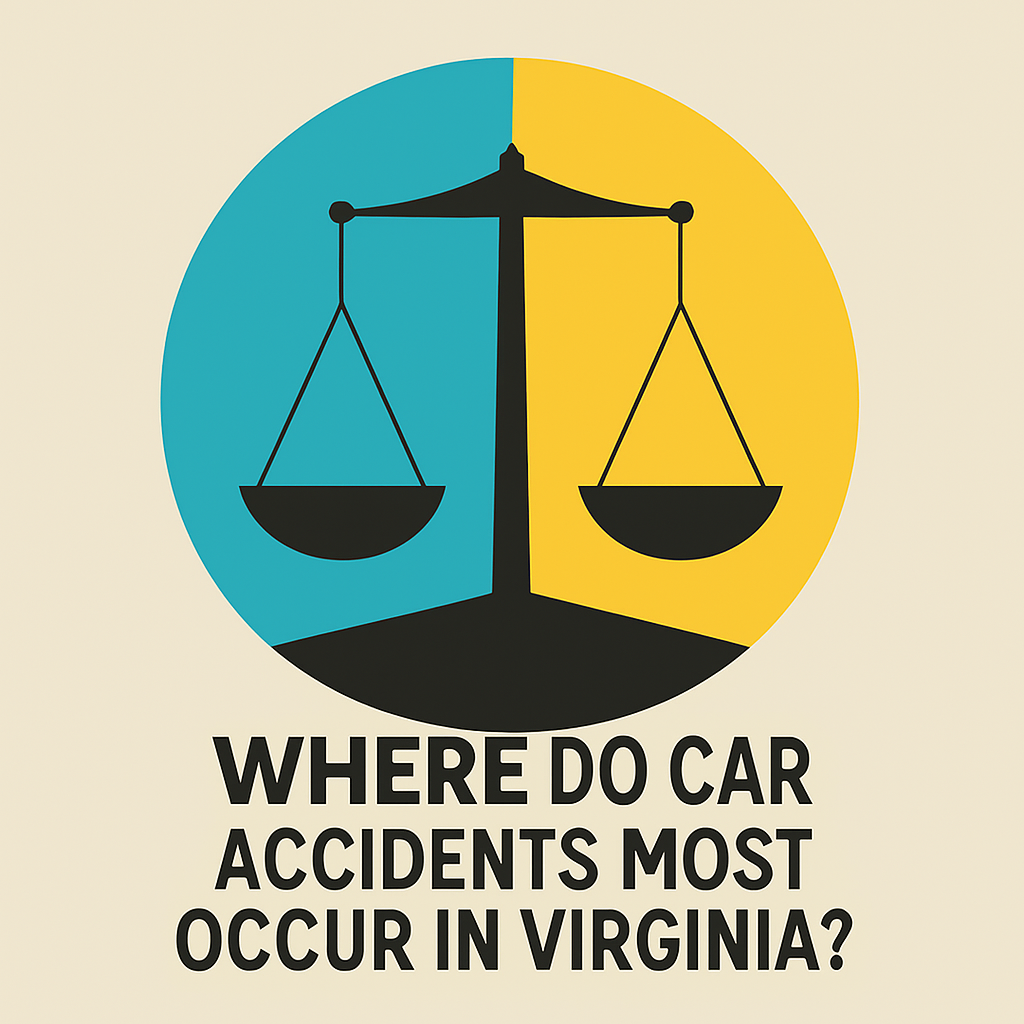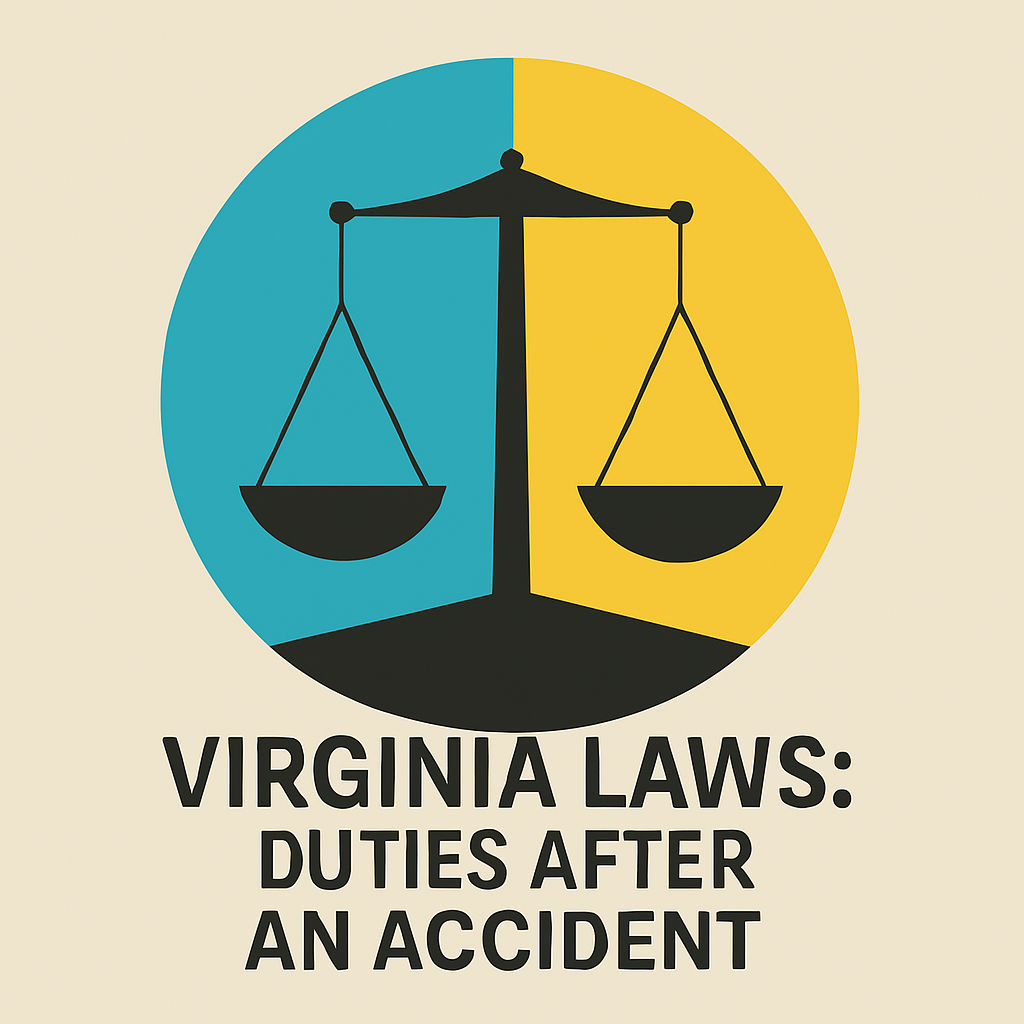More than 120,000 car accidents happen each year on Virginia’s roads. That is about one crash every 4.3 minutes, and about 2.8 people die daily in these accidents.
This guide looks at where most accidents happen, which roads are the most dangerous, and what Virginia law says about your duties after an accident.

Counties with the Most Accidents
Fairfax County: The Busy Traffic Hotspot
- Fairfax County has the highest number of crashes (over 11,000 each year), injuries (nearly 5,000), and fatalities (about 66).
- A large population, lots of commuters, and complicated roads make Fairfax County a top accident zone.
Other High-Risk Counties
- Prince William, Hanover, and Henrico are also high on the list.
- Busy highways and regular rush-hour backups increase the likelihood of serious accidents.
Regions and Crash Rates
When we compare how many accidents happen based on miles driven (called crashes per million vehicle miles traveled):
- Hampton Roads has about 1.8 crashes per million, the highest rate in Virginia 11.
- Roanoke Valley/Alleghany has 1.7 crashes per million
- Richmond has 1.63 crashes per million
- Northern Virginia has 1.41 crashes per million
Even though Northern Virginia has many crashes, the miles driven are so high that the rate is lower than in Hampton Roads or Roanoke.
Most Dangerous Highways and Roads
Interstates with High Crash Counts
- I-64 (Exits 261A–264): Has had multiple fatal accidents, about one every three miles 55.
- I-95:
- Between Exits 160A and 166A (Prince William & Fairfax Counties): Crashes happen roughly every two miles 55.
- Around mile markers 161, 162, 163, 173 (Fairfax), plus areas near Exit 92A (Hanover) and markers 78–79 in Richmond 1,3,51,3,5.
- I-495 (Capital Beltway): High-risk spots near mile markers 1, 3, 9, 14, and 15 11.
- I-66: Frequent crashes near mile markers 6, 54, 60, 63, 64, and 65 11.
Non-Interstate Danger Zones
- Hull Street Road (Richmond) 55
- Hampton Roads Beltway (Exits 281–274 in Norfolk) 55
- US-13 (Virginia Beach & Norfolk) 55
- Mechanicsville Turnpike (Hanover & Henrico) 55
- US-1 (Richmond) 55
- Brock Road (Spotsylvania County) 55
High-Risk Intersections
Intersections are tricky because cars cross paths. Some of the worst include:
- Leesburg Pike (Route 7) & Chain Bridge Road (Route 123) in Tysons 44
- I-95 & Route 1 in Alexandria 44
- Broad Street & Glenside Drive in Richmond 44
- Independence Blvd. & Virginia Beach Blvd. in Virginia Beach 44
- Jefferson Ave. & Oyster Point Rd. in Newport News 44
Urban Areas with Frequent Accidents
Richmond
- 17th & 18th Streets, Broad Street, Oliver Hill Way, Belvidere Street, Clay Street, Leigh Street, Munford Street, Cowardin Avenue, Hull Street, Richmond Highway.
- These roads are known for heavy traffic and confusing layouts.
Norfolk & Virginia Beach
- Norfolk: I-64 (mile markers 284, 272), I-264 (mile markers 7, 8, 10, 14), plus Northampton Blvd., Premium Outlets Blvd., Wesleyan Dr.
- Virginia Beach: I-264 (mile markers 15, 16) and many local streets like Indian River Rd., Kempsville Rd., and Laskin Rd.
Main Causes of Accidents in Hotspots
- Traffic Volume: More cars often means more crashes—especially in busy counties like Fairfax.
- Road Design: Complex interchanges and poor signage lead to confusion and accidents.
- Driver Behavior: Speeding, drunk driving, and texting are major reasons for crashes.
Virginia Laws: Duties After an Accident
In Virginia, drivers (and sometimes passengers) have legal duties when a crash occurs. These rules aim to protect public safety and help injured people get care.

Stopping and Assisting
- Va. Code § 46.2-894:
- If you are involved in a crash with injury, death, or property damage, you must stop as close to the scene as possible.
- You must give your name, address, license number, and vehicle info to the police, the other driver, or the property owner.
- You must also offer help—for example, taking an injured person to the hospital if needed.
- If you do not stop and it is a serious crash, you could face a felony or misdemeanor charge, depending on the damage amount.
In Aley v. Commonwealth, 75 Va. App. 54, the driver ignored a passenger who repeatedly asked for a hospital trip. The court said refusing to help violated § 46.2-894.
Reporting Accidents
- Va. Code § 46.2-371:
- If a crash causes injury or death, the driver must immediately tell law enforcement.
- Not reporting can be a Class 4 misdemeanor.
Unattended Property
- Va. Code § 46.2-896:
- If you damage unattended vehicles or property, you must try to find the owner.
- If you cannot find them, leave a note with your info and report the crash in writing to the police within 24 hours.
Passenger Responsibilities
- Va. Code § 46.2-895, 46.2-897:
- If the driver does not stop or report, anyone 16 or older in the car (who knows about the accident) must make a report to police within 24 hours.
Virginia Court Cases on Accidents and Insurance
- Brown v. Kirkpatrick, 79 Va. App. 252:
Deals with underinsured motorist (UIM) coverage. UIM money is not a “free extra” (not a collateral source). - United Servs. Auto. Ass’n v. Estep, 77 Va. App. 16:
Loading luggage was counted as being “in” the vehicle. The injured person qualified for coverage. - Gossett v. Jackson, 249 Va. 549:
Even if a car is in bad shape mechanically, a driver speeding or losing control can still be found negligent. - Chodorov v. Eley, 239 Va. 528:
“Sudden emergency” and “unavoidable accident” defenses don’t always apply. Drivers must be prepared for traffic stops.
Insurance Rules and Accident Coverage
- 14 VAC 5-141: Definitions about “accident only coverage” and how “accidental injury” must directly result from an accident (not from sickness).
- 24 VAC 20-40-10: Explains what a “motor vehicle accident prevention course” is and how drivers can complete it.
- 14 VAC 5-141-50: Shows what’s covered under “accident only” insurance, including when injuries are or are not included.
Staying Aware of Accident Hotspots in Virginia & Following Virginia’s Rules
Virginia sees many car accidents each year, especially in high-traffic counties like Fairfax. Regions like Hampton Roads have the highest crash rate per mile, and highways I-64 and I-95 often top the list of dangerous road segments. Intersections in Tysons, Richmond, Virginia Beach, and Newport News also pose big risks.
If you are in a crash, state law requires you to stop, help any injured person, and report the accident. Failing to do so could lead to serious legal consequences. Passengers may also need to step up and inform the police if the driver does not.
By staying aware of accident hotspots and following Virginia’s rules, drivers can help make roads safer for everyone.
(This article is for educational purposes and does not replace legal advice. If you need help with a crash-related matter, consider reaching out to a licensed attorney. Read more articles on Ask Law Easy to stay informed.)